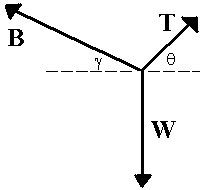Lesson Plan
Day Goals:
Introduce the background ideas of magnetism.
Reveal student conceptions/explanations of magnetic phenomena.
Student Learning Objectives:
Demonstrate the effect of one magnet on other magnets.
Demonstrate that attraction and repulsion are related to relative
geometric orientation of the magnets and not external parameters.
Demonstrate that magnetic strength increases as separation decreases.
Demonstrate that certain types of materials in the environment, while
not themselves magnetic, do interact with magnets.
Preparation:
Prepare packs of material for each group. Include in each pack:
- several bar and ring shaped magnets
- pieces of various metals (copper, aluminum, brass, foil)
- a metal box (a candy tin or coffee can)
- a plastic container (a film canister or margarine container)
- metal paper clips
- wood
- styrofoam
- string and/or thread
- rubber bands,
- a 1 foot length of 1/2 inch copper tube
- a 1 foot length of 1/2 inch PVC
- cellophane tape
- a small metric ruler
- a pencil
- a lump of clay
- 10 metal washers which fit on the pencil (1/4 inch)
Web Resources:
- For a brief introduction to magnetism written by a student:
http://gamma.mhpcc.edu/schools/hoala/magnets/magnet.htm - For a brief discussion of the history of Western understanding of magnetism
(and electricity) see Michael Fowler's essay at:
http://galileoandeinstein.physics.virginia.edu/more_stuff/E&M_Hist.html - For a time line which includes non-Western knowledge of magnetism (and
electricity and optics, closely related topics):
http://history.hyperjeff.net/electromagnetism.html - On magnetic levitation:
http://www.dmoz.org/Science/Physics/Electromagnetism/Magnetic_Levitation/
Opening Discussion: (5-8 minutes)
Magnetism has been 'used' for several thousand years.
Magnetism has been understood by science for c. 150 years.
Magnetic objects exert a force on other magnetic objects and act in a particular direction.
Student Activities with Materials
- Work with magnets to verify attraction, repulsion happens.
- Agree to a sign convention that allows them to designate the relative sign of the ends of a magnet.
- Work with ring magnets and washers stacked on pencil to determine magnetic force of interaction is inversely related to separation.
- Work with magnetic pendulum to determine how pieces of metal, wood, string, rubber or the plastic and metal boxes alter the attraction or repulsion between two magnets.
- Drop a magnet through the copper and plastic tubes to discover whether magnets alter and modify the space they are located in.
- Attempt to magnetize a paperclip.
Closing Class Discussion
Lead discussion that draws out the student observations made during activity.
- Review each task and collect student observation on the black board.
- Probe students thinking about possible external phenomena affecting magnet actions. Possible responses might include gravity and friction, earth's magnetic field, temperature, light.
- Probe students thinking about the relationship between a magnet's proximity and the strength with which it pulls on another magnet or material.
Suggested Homework Assignments
Ask students to design a method for detecting a magnetic field.
(A possible hint is to remind them of the nature of Newton's Third
Law: that which feels the force must also be able to exert the same force.)
Ask students to design a method for determining the strength of a magnet.
(Quite hard to do as you need a reference magnet of known strength. The method of
choice is to use a current or a Hall Effect probe but students don't know this.)
Ask students to design a method to find the dependence between
separation of magnets and the force of interaction.
(Quite hard to do as assumptions about center of magnet coinciding with center
of mass and rotational effects have a significant effect.)
Use Newton's Law to calculate the magnetic force of interaction on
a magnetic pendulum in the vicinity of a 2nd magnet. The students cannot
assume the magnetic force is completely horizontal. The following free body
diagram is suggested:

The smallest angle of B with the horizontal is gamma. The larger angle of T with
the horizontal is theta. The weight (mg) is along the downward vertical. Find
B(gamma,theta,W). Solve for the three cases
gamma = 0°, gamma = 90°, gamma = theta.
Lesson Development/Writing: Ed Eckel
Web Design: Theresa Valentine
Last Updated: 8/15/2000
